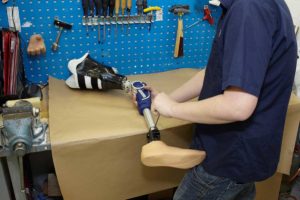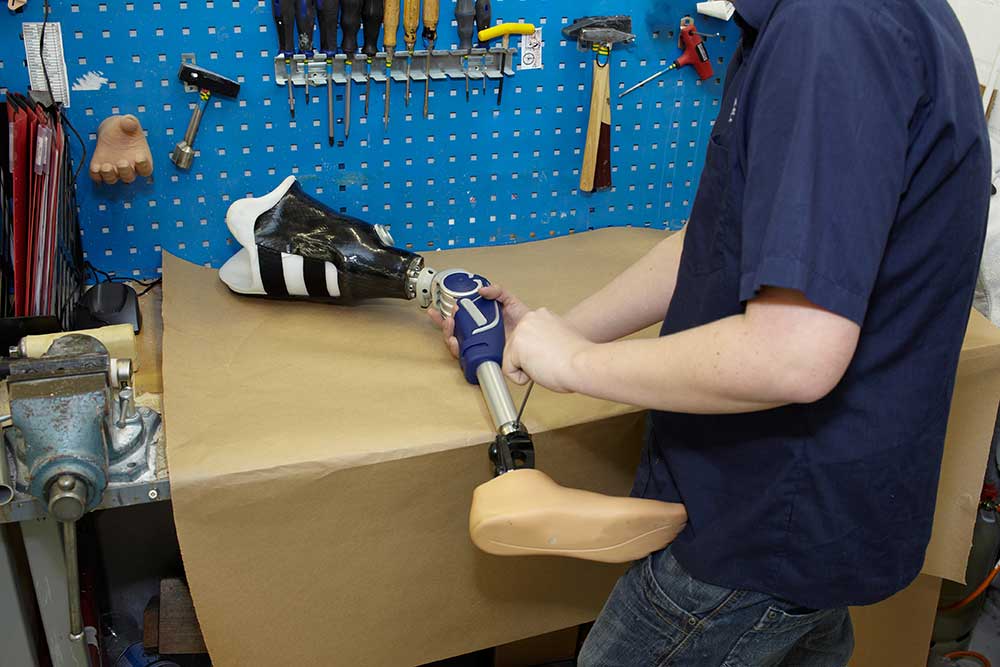Disclaimer: The information on our website is provided for general information purposes only. We make no representations or warranties of any kind, express or implied, about the completeness, accuracy, reliability, suitability or availability with respect to the website or the information contained on our website for any purpose. Any reliance on such information is therefore strictly at your own risk and we are not liable for any damages or losses arising out of or resulting from your reliance on any information contained on our website.
A Medical Appliance Technician is akin to an artisan in the realm of healthcare, specializing in the intricate craft of medical support devices. In fact, these skilled professionals blend the precision of engineering with the compassion of medical care. Additionally, they design, fabricate, repair, and tailor-fit a variety of assistive devices, including braces, prosthetics, and other supportive equipment. Watch a video to learn more.
How to Become a Medical Appliance Technician

Becoming a Medical Appliance Technician often involves a blend of formal education and hands-on experience. While it might be challenging to find local colleges or vocational schools offering specialized courses in this field, there are pathways to enter and thrive in this career. A high school diploma is commonly the minimum educational requirement, paving the way for on-the-job training opportunities, where aspiring technicians can gain practical experience under the guidance of seasoned professionals.
To prepare for this role, taking relevant courses during high school or at a community college can be incredibly beneficial. Subjects such as anatomy and physiology provide crucial insights into the human body, essential for understanding how medical appliances interact with and support various body parts. Courses in science, particularly biology and physics, offer foundational knowledge that underpins the technical aspects of appliance design and function. Mathematics is also important, as it sharpens problem-solving skills and aids in precise measurements and calculations needed in device fabrication.
Additionally, classes in shop, including woodworking and mechanics, are invaluable. They develop the hands-on skills needed for the crafting and repairing of appliances, such as using tools, understanding materials, and following technical specifications. For those who are unable to find specific courses in medical appliance technology, programs in related fields such as orthotic and prosthetic technology can also provide relevant skills and knowledge.
Beyond formal education, pursuing internships or apprenticeships in medical appliance manufacturing or repair facilities can offer practical experience and a deeper understanding of the field. Networking with professionals in the industry and joining relevant associations can also open doors to job opportunities and further training.
Benefits of becoming a Medical Appliance Technician
Choosing a career as a Medical Appliance Technician offers a unique blend of personal fulfillment and professional growth. One of the most significant benefits is the profound impact on individuals’ lives; technicians directly contribute to enhancing the quality of life for people with physical challenges by creating and fitting medical devices like prosthetics and orthotic braces. This role offers a deep sense of accomplishment, as each day brings the opportunity to make a tangible difference. Additionally, the field of medical appliance technology is one that combines creativity with technical skill, providing a dynamic and intellectually stimulating work environment.
Technicians continuously develop and refine their skills in both craftsmanship and technology, ensuring that their career never stagnates. Furthermore, with the growing demand for personalized medical devices driven by an aging population and advancements in medical technology, the career prospects in this field are robust and expanding. This not only promises job security but also opens up possibilities for advancement and specialization. Also, for those who value autonomy and variety in their work, this career offers a balance of independent projects and collaborative efforts with healthcare professionals. Lastly, becoming a Medical Appliance Technician does not necessarily require extensive higher education, which can lead to a quicker entry into the workforce and less student debt compared to other medical professions.
Job Description of a Medical Appliance Technician
This is an interesting field as technicians may find themselves using Computer-Aided Design (CAD) software in the morning to design a device. Then, in the afternoon they could be using hand or power tools to drill or weld parts together or work with material such as leather or fabric to cover a device. These technicians are also detail-oriented as they read the specifications needed for a device and they may even receive a cast of a patient’s body part to use to assist in fine-tuning those specifications. This information assists the medical appliance technician to design a functional device for a patient.
A Medical Appliance Technician’s role is a harmonious blend of manual dexterity and technological proficiency, utilizing an array of hand tools, advanced power tools, and sophisticated computer software for design and customization. Their role is not just technical but also deeply personal, as they work closely with patients to ensure each device enhances the individual’s quality of life, addressing unique physical challenges with bespoke solutions. In this way, Medical Appliance Technicians play a pivotal role in empowering individuals, helping them regain mobility and independence through their expert craftsmanship and technological acumen.
Medical Appliance Technician Career Video Transcript
Medical appliance technicians combine a knowledge of human anatomy with math and power tools to create artificial limbs and braces. Their work supports other medical experts who use devices to help patients overcome a physical limitation. These technicians read prescriptions and detailed information about what a patient needs. They often work from a cast or impression, measuring with precision instruments, and then creating an appliance or new limb with the help of design software.
Typically, technicians use hand or power tools to cut and shape the new limbs. They glue, rivet, or weld the parts together. However, the use of 3D printer technology is growing rapidly, allowing for better fit and function than traditional prostheses. In either case, the final steps include smoothing the surfaces, and padding or covering them. Devices are then tested, adjusted, and eventually, repaired and maintained.
Requirements vary from high school or equivalent to vocational training or an associate’s degree. While there are few courses available in the field of orthotic and prosthetic technicians, classes in shop, math, science and anatomy are helpful. Most learn technical skills on the job. Appliance technicians are medical mechanics. The appliances they build help people achieve physical function and form, as well as independence and productivity.
Article Citations
Bureau of Labor Statistics, U.S. Department of Labor, Occupational Outlook Handbook, Dental and Ophthalmic Laboratory Technicians and Medical Appliance Technicians.
National Center for O*NET Development. 51-9082.00. O*NET OnLine.
The career video is in the public domain from the U. S. Department of Labor, Employment and Training Administration.

